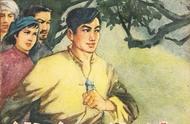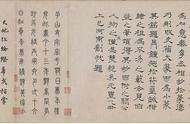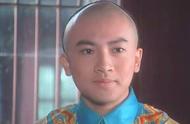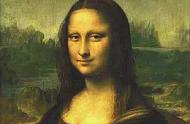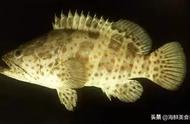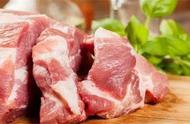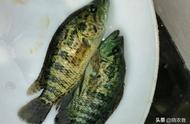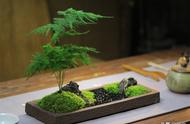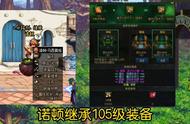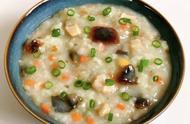Dwelling in the Fuchun Mountainsis one of the few surviving works by the painter Huang Gongwang (1269–1354). The painting is created based on the Fuchun river’s early autumn scenery. Huang made full use of the Chinese traditional techniques. The arrangement is a masterpiece of movement and stillness as well as density and expansiveness. The ink likewise ranges from extremely dry to moist, and the strokes also vary from centered brushwork to slanted.
《富春山居图》为画家黄公望(1269—1354)少数的存世作品之一。画家充分利用水墨技法描绘了富春江一带的初秋景色,山水布置动静结合,疏密得当,墨色浓淡干湿并用,中锋圆浑、侧锋峻峭,极富变化。
Painted between 1348 and 1350, the Chinese landscape painting was burnt into two pieces in 1650. Today, one piece is kept in the Zhejiang Provincial Museum in Hangzhou, while the other piece is kept in the Taipei Palace Museum. The entire painting combined would measure 691.3 cm in length.这幅山水画作于元至正八年(1348 )到至正十年(1350),清顺治七年(1650 )曾遭火焚,断为两段。现分藏于浙江省博物馆和台北故宫博物院。两段相加横691.3 厘米。
Spring Morning in the Han Palace
《汉宫春晓图》
Created by the Ming Dynasty (1368–1644) painter Qiu Ying (ca. 1494–1552), Spring Morning in the Han Palaceis a silk scroll painting noted for its bold use of colors. With a length of 574.1 centimeters and a width of 30.6 centimeters, it is considered very large relative to other similar decorative artwork. Qiu Ying is one representative painter in the Ming Dynasty, and is regarded as one of the Four Great Masters of the Ming Dynasty along with Shen Zhou (1427–1509), Wen Zhengming (1470–1559) and Tang Yin (1470–1523).
《汉宫春晓图》是明代(1368—1644) 画家仇英( 约1494—1552) 的一幅绢本仕女画,纵30.6 厘米,横574.1 厘米,以其大胆的色彩运用而闻名。 就装饰绘画而言,《汉宫春晓图》堪称巨制。仇英是明朝代表画家,与沈周(1427—1509)、文征明(1470—1559)、唐寅(1470—1523)合称“明四家”。
This long scroll is an imaginary representation of various activities in a Han Dynasty (206BC–220AD) palace on a spring morning. The intricate composition is rendered with crisp brushwork and beautiful colors. Trees and rocks decorate and punctuate the garden scenery of the lavish palace architecture, creating marvelous scenery similar to that of immortal realms. In addition to the groups of beauties, leisure activities of the literati, such as the zither, chess, calligraphy, and painting as well as appreciating antiquities and planting flowers are depicted, making it a masterpiece among Qiu Ying’s historical narrative paintings.《汉宫春晓图》以春日晨曦里的汉代(公元前206—公元220)宫廷为题,以长卷的形式描绘了宫闱的各种日常活动。构景繁复,用笔清劲,赋色妍雅,林木、奇石与华丽的宫阙穿插掩映,铺陈出宛如仙境般的瑰丽景象。除却美女群像之外,复融入琴棋书画、鉴古、莳花等文人雅士的休闲活动,实为仇英历史故事画中的精彩之作。
One Hundred Horses
《百骏图》
One Hundred Horseswas drawn by Lang Shining in the Qing Dynasty (1644–1911). Lang was a missionary from Italy with birth name Giuseppe Castiglione. Working as a court painter in China for over 50 years, his talent in painting was regarded highly by Chinese emperors Kangxi, Yongzheng and Qianlong. He helped to create a hybrid style that combined the Western realism with traditional Chinese composition and brushwork.
《百骏图》, 清(1644—1911)郎世宁所绘。郎世宁,意大利传教士,原名朱塞佩·伽斯底里奥内。郎世宁任宫廷画师五十多年,画才深得康熙、雍正、乾隆赞许。他将西洋现实主义手法与中国传统构图和笔法相融合,开创了一种中西杂糅风格。
This paper painting, 813 cm long and 102 cm wide, captures 100 horses in various postures. They are kneeling, standing, frolicking, rolling, eating and running on the grassland—staying alone and among groups. The artwork is now preserved in the Taipei Palace Museum.《百骏图》,纸质稿本,纵102 厘米,横813 厘米。此图共绘有100 匹骏马,在草地上或跪或立,嬉闹翻滚,觅食奔跑,聚散不一,姿势各异。现藏台北故宫博物院。
来源:《英语世界》译者:卜杭宾
来源:英语世界

